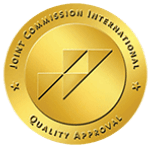Drug and Alcohol Withdrawal Management
To begin, it’s important to understand what withdrawal actually is. Also known as detox, withdrawal is the process of entirely stopping the use of a substance and allowing your body to remove the substance from your system. As a result of regular use, you probably developed a psychological or physical dependence on the substance. Because of this, the sudden halt in using the substance can cause unpleasant and uncomfortable symptoms that range from mild to severe.
Withdrawal syndrome happens in people who have built a physiological dependence on a substance and then discontinue or reduce their use. It can occur with a broad range of substances including alcohol, illicit drugs, and prescription medicines.

The severity of a person’s withdrawal symptoms depends on factors such as:
- Duration of substance use
- Amount used and frequency
- Your age
- The substance
- Your general health
- Your psychological characteristics
Fortunately, withdrawal syndrome can be managed with professional medical care. There are medications that can be prescribed to help relieve the cravings for the substance and the distressing physical symptoms that may occur.
What Causes Withdrawal Symptoms?
When an individual regularly uses a substance, their body and mind get used to that substance. At first, the substance disturbs the balance in the body, but then the body adjusts to having the substance present and registers it as normal. When you stop consuming the substance, the resulting withdrawal symptoms come from your body’s adjustment to the continuous presence of the substance. A person who has developed a dependence might feel like they need the drug just to be able to think and function normally.
Two Types of Withdrawal
You can be psychologically or physically dependent, or both, on a substance.

Physical dependence has an effect on your body. Your body begins to rely on the substance and it has a bad reaction to a sudden stoppage. The addictive chemicals in drugs can cause variations in the chemical levels in your brain. This changes your brain and leads to physical dependence.
Common physical withdrawal symptoms include:
- Depression
- Sleeping problems
- Anger
- Gastrointestinal problems
- Shaking or trembling
- Seizures
As you can tell from the name, psychological dependence is when you become mentally and emotionally dependent on a substance. You might begin to believe that you need the substance just to function socially, to get through your day, to relax and unwind, etc. This type of dependence affects how you behave, especially when you’re trying to quit using.
Common psychological withdrawal symptoms include:
- Feeling like quitting is not an option for you
- Continuing your substance use even after negative consequences are obvious, such as health problems
- Obsession with getting and using the substance
- Feeling that you need to use the substance just to get through life
- Developing a dependency and tolerance
- Starting high-risk behavior to get your next dose, such as buying from strangers
A lot of people experience a combination of psychological and physical withdrawal symptoms, but it doesn’t mean they can’t both be overcome.
What is Withdrawal Management?
While your mind and body are working against your sobriety during withdrawal, it is important to get professional help. For some people, detox can be a life-threatening experience and medical issues may appear. Because of this, detoxing in a professional setting with medical staff is the safest option. Rehab facilities can make sure you go through withdrawal safely.
Some treatment facilities, including Bayview Recovery, offer medication-assisted treatment (MAT). This type of medical detox reduces the shock and stress of quitting on your body and mind, easing the severity of withdrawal symptoms and reducing the risk of medical complications.

Which Substances Require Withdrawal Management?
Alcohol withdrawal syndrome (AWS) is one of the most common signs of alcohol dependence. AWS is a cluster of symptoms that begin in alcohol-dependent people after stopping or reducing alcohol use after heavy or long-term abuse. The clinical symptoms vary from mild to severe and the onset of symptoms usually happens just a few hours after the last alcohol ingestion.
Most of the withdrawal symptoms from alcohol will conclude within several days but they can last longer. Symptoms may include:
- Anxiety
- Loss of energy
- Delirium
- Fever
- Feelings of confusion
- Hallucinations
- Emotional outbursts
- Memory problems
- Dizziness
- Insomnia
- Nausea and vomiting
- Seizures
- Shaking
- Sweating
- Trembling
- Higher blood pressure
Withdrawal from alcohol can have severe symptoms that could lead to death. That’s why it’s important to get professional help when cutting down or stopping alcohol consumption. Our alcohol rehab in Washington can help you today.
What are Delirium Tremens (DTs)?
A sure sign of alcohol withdrawal syndrome is a continuum of signs and symptoms that range from simple trembling to delirium tremens. The sequence varies greatly, and symptoms may overlap in time and duration. DTs are an extreme symptom of alcohol withdrawal that can cause death so it needs to be considered a medical emergency that requires immediate medical care. Symptoms may include:
- Severe agitation
- Disorientation
- Increased body temperature
- Increased heart rate
- High blood pressure
- Hallucinations
- Paranoia
- Heavy sweating
- Trembling
Withdrawal Management
People with mild alcohol withdrawal can be treated on an outpatient basis as long as there aren’t any underlying conditions that require inpatient treatment. People with moderate or severe alcohol withdrawal and DT will need inpatient treatment and possibly admission to a hospital.
Over the years, the treatment for alcohol detoxification has evolved from the use of a tapering off schedule of alcohol itself to the use of benzodiazepines and other sedative-hypnotic drugs. These drugs are now the primary treatment. This is because they are “cross-tolerant” drugs. Cross-tolerance happens when developing a tolerance for one substance leads to developing a tolerance for another.
Benzodiazepine withdrawal can also lead to death so it’s important to get professional medical assistance for withdrawal from this substance. We treat all withdrawal symptoms at our benzo addiction treatment center in Washington. After long-term use of these narcotics, withdrawal symptoms resemble those of alcohol withdrawal.
Sedative-hypnotic withdrawal features noticeable psychomotor (eye-hand coordination) and autonomic (regulation of internal organs) dysfunctions. The first signs of withdrawal usually start within 6 to 8 hours for shorter-acting benzodiazepines and 24 to 48 hours for the longer-acting forms.
The withdrawal symptoms of benzodiazepines include:
- Anxiety
- Cravings
- Depression
- Sleep problems
- Sweating
- Headache
- Heart palpitations
- Panic attacks
- Seizures
- Muscle stiffening
- Trembling
- Tension
Withdrawal Management
Withdrawal from sedative-hypnotic drugs is treated by substituting drugs that have a long continuance of action. This may be either a benzodiazepine or phenobarbital, given for a few days in a maintenance dose and then gradually decreasing the dose over 2 to 3 weeks.
Short-acting benzodiazepines are important because of the intense and serious withdrawal symptoms people experience when they quit taking them. Long-acting benzodiazepines cause less intense withdrawal symptoms, and it takes longer for symptoms to start.
Individuals who are heavily dependent on benzodiazepines may also experience post-acute withdrawal symptoms (PAWS). These are random periods of acute withdrawal symptoms after quitting. Tapering down use with the help of a physician can prevent PAWS.
Opioid withdrawal can lead to potentially serious medical complications and relapse, which makes it important to have professional support through the detox process at an opioid rehab. The symptoms range from mild to severe and may last a few days to a few weeks. Withdrawal from opioids produces a characteristic syndrome similar to a viral illness.
Symptoms of opioid withdrawal include:
- Sneezing
- Agitation
- Aches and pains,
- Abdominal cramping
- Diarrhea
- Anxiety
- Nausea and vomiting
- Yawning
- Watery eyes and runny nose
- Increased blood pressure or heart rate
- Dilated pupils
- Heavy sweating
- Sleep problems
- Goosebumps
- Leg cramping
Withdrawal Management
Withdrawal from opioids is treated with prescription medications such as:
- Methadone
- Buprenorphine (long-acting opioid agonists) tapered over days or weeks
- Clonidine every 4 to 8 hours (to reduce the severity of symptoms)
- Long-acting benzodiazepines (to control muscle cramps and insomnia)
Stimulant withdrawal, or wash-out syndrome, looks like severe depressive disorder. Symptoms of stimulant withdrawal vary from mild to severe and can last from a few days to a few weeks or longer for some people.
Symptoms that go on after two weeks are considered post-acute withdrawal syndrome (PAWS), which may last from 12-18 months depending on the individual. At our stimulant addiction treatment in WA, we provide support for symptoms such as depression, particularly if the person is having suicidal thoughts.
The symptoms of withdrawal include:
- Depression
- Excessive sleeping
- Hunger
- Severe psychomotor impairment
- Body aches
- Anger and irritability
- Seizures
- Anxiety
- Sleep disturbances
- Chills
- Memory problems
Symptoms of PAWS include:
- Sleep problems
- Anxiety
- Depression
- Irritability
- Problems concentrating
- Fatigue
- Mood-swings.
Withdrawal Management
Stimulant withdrawal syndrome is typically treated by observation and does not require specific medications. However, medical detox programs can help manage withdrawal symptoms, making the process more bearable and efficient, Ensuring that the individual is able to complete detox without relapsing.
Depending on the stimulant, a patient may be advised to quit the drug “cold turkey” or by gradually reducing use, called tapering. Generally, a taper method will cause less severe withdrawal symptoms. Sometimes, medication like clonidine, is used in place of stimulants when tapering off use. Physicians may also treat some symptoms of stimulant withdrawal with antidepressants to help with depression and agitation and Trazodone may be used to treat insomnia.
What is Polysubstance Abuse?
Polysubstance use involves consuming more than one drug at the same time. Even though it typically refers to the misuse of multiple illicit drugs, it also includes prescription medications being used in nonmedical situations. Sometimes it’s referred to as polysubstance addiction or polysubstance abuse.
Unintentional
In some cases, people on prescription medication might combine substances unintentionally. They might have a few drinks without being aware that their prescription medication should not be combined with alcohol. At other times, they may be taking several medications from different doctors, not knowing that the prescriptions negatively interact with one another.
Intentional
At times people take part in polysubstance misuse on purpose in an effort to experience increased effects from multiple substances. Frequently, people have a preferred substance that they combine with other substances to enhance the preferred substance’s effects. Though combining certain substances may enhance the desired effects, it also enhances the negative effects.
Withdrawal from multiple substances at one time is more complicated than from a single substance. Because of the unpredictability of withdrawal from multiple substances, constant medical monitoring is always necessary. Generally, an inpatient medical detox in a hospital or professional detox center is recommended. This makes sure that 24-hour monitoring and medical supervision are available at all times.
Supervising physicians often prescribe medications to counteract certain withdrawal symptoms such as anti-nausea meds or antidepressants. Long-term maintenance medications may also be prescribed in cases of prescription opioid or heroin abuse. In other cases, such as benzodiazepine withdrawal, a tapering approach may be used.
Unfortunately, it’s common for people who complete detox to relapse into substance abuse. The detox process removes the drug from the person’s system. It’s not realistic to believe that withdrawal management will continue to sustain abstinence. Instead, detox is an important first step before the person begins psychosocial (involving both psychological and social aspects) treatment.
The process of withdrawal management refers to both the psychological and medical interventions applied to individuals recovering from substance abuse. Providing withdrawal management in ways that reduce discomfort and show empathy can help build trust between patients and staff. This makes further psychological and behavioral therapies more effective.
Begin Your Journey at Bayview
Do you need help? Are you interested in helping a loved one? Bayview Recovery in Tacoma, WA is able to provide a full continuum of care so you can begin and continue your recovery journey in one location with one personalized treatment team. This includes that vital withdrawal management with our medication-assisted treatment program (MAT).
Because we know that people respond better in peer groups, we can offer specialized programs for men, women, and young adults. This is too important to leave to chance. Contact us today and discover all that we can do for you or someone you care about.

Dave Cundiff, MD, MPH is an experienced leader in the field of Substance Use Disorder treatment. He works with patients suffering from Substance Use Disorder to evaluate their medication needs and prescribe treatments accordingly. In addition, he regularly participates in all-staff debriefing sessions involving peers, nurses, and other prescribers. He also reviews and advises on policies, procedures, and techniques for treating substance use disorder.




